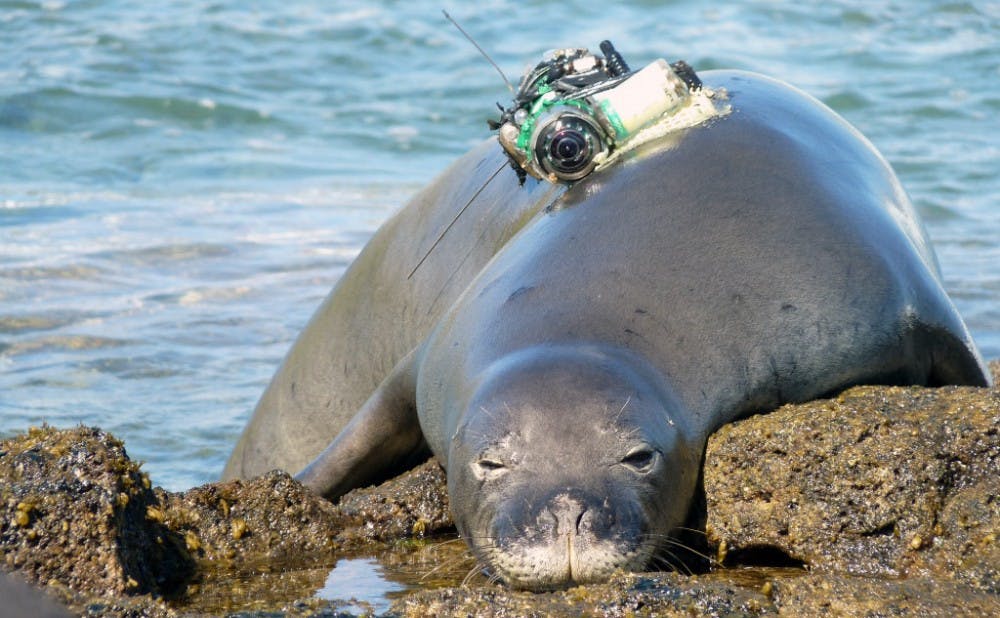Although a lot of research happens in labs, one undergraduate student’s summer research took her to the Hawaiian Islands to see through the eyes of a monk seal.
Junior Emma Weitzner traveled to the northwestern Hawaiian Islands to aid in the recovery of the critically endangered Hawaiian monk seal populations, with people from the lab of Andy Read, Stephen Toth professor of marine biology. The team of researchers strapped special video cameras, known as CritterCams, to the seals’ backs. They analyzed the seals’ behavior and impact on the marine environment in order to educate Hawaiians.
“It was like I was snorkeling on the back of a seal,” said Weitzner, who reviewed the collected footage.
The CritterCam was first used by National Geographic for studying marine species in the late 1980s. Because of its ability to take underwater footage, the CritterCam was especially useful for monitoring the habitats, feeding behavior and movements of the monk seals.
“By getting the video footage, we’re able to see...all sorts of things that we would not even come close to knowing if we didn’t have visual confirmation,” said Kenady Wilson, a Ph.D. candidate at the Duke University Marine Lab and Weitzner’s research mentor.
The research focused on the seals’ behavior, including where they went and how much they ate. The group found six different seals and fitted them with CritterCams, accelerometers and GPS tags to track their precise movements.
For Weitzner, this was the part of her experience where she got some hands-on exposure to the monk seals.
“I [had] to help restrain the seals, so what I usually did was hold down the back flippers,” Weitzner said. “On one of the deployments, I helped the vet prepare the seal for its IV, and I helped collect the samples and prepare them for storage.”
After analyzing the footage, Weitzner noted that what she found most interesting about the data was the predatory activity of the seals. Although the six seals came into contact with around 8,000 different species of prey, they only captured and fed on 24 of them, she said.
Contrary to public opinion on the Hawaiian Islands, the results suggested that the monk seals were not depleting the fish populations at an alarming rate, an argument commonly used to justify seal hunting.
“In the main Hawaiian Islands right now, monk seals are getting killed because the locals and the fishermen think they’re eating an overabundance of their fish,” Weitzner said. “Increased dissemination of this information that we’ve been gathering is really important to promoting the conservation of these animals.”
Because the CritterCam can translate scientific observation into easily understood footage, it has become a crucial medium for public outreach. In August, Wilson organized a showing of “An Evening with Seals through the Eyes of the Seal: Understanding the Secret Lives of Monk Seals.” Screened for a large audience in the Honolulu Museum of Art, the movie used footage from the CritterCam to promote social awareness for the seals.
Wilson noted that the team’s efforts are part of an ongoing campaign to educate locals and to address any concerns or fears about the seals’ lifestyle.
“The project definitely won’t end when I’m personally done with my dissertation,” Wilson said. “It’s going to be a long process for our collaborators in Hawaii to keep working with the community on dispelling these myths and trying to cultivate some acceptance or coexistence between seals and people.”
The summer research opportunity that Weitzner participated in was among the many independent study options available to Duke students.
“The sustained investigations that are possible from this type of [fieldwork] really give students an understanding of what it is like to be a scientist,” said Julie Reynolds, associate director of undergraduate studies in biology.
Weitzner is now seriously considering a future profession in the field of marine biology, largely due to her experience with the CritterCam.
“It just cemented that I want to do fieldwork with marine mammals for the rest of my life,” Weitzner said.
Get The Chronicle straight to your inbox
Signup for our weekly newsletter. Cancel at any time.

